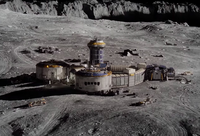Portal:Aurorum/Featured article: Difference between revisions
No edit summary |
No edit summary |
||
| (4 intermediate revisions by 2 users not shown) | |||
| Line 1: | Line 1: | ||
<div style="float:left;margin:0.5em 0.9em 0.4em 0;">[[File: | <div style="float:left;margin:0.5em 0.9em 0.4em 0;">[[File:Haller Base facilities on the surface.png|200px]]</div>'''Haller Base''', officially the '''Haller Base–Lunar Research Station''' ({{wp|German language|Hesurian}}: ''Haller-Basis Lunare Forschungsstation''), is a [[Mascylla|Mascyllary]] {{wp|Exploration of the Moon|research station}} on the sloped rim of the {{wp|Polybius (crater)|Jenssen E crater}} in the Soguichi Plateau, on the surface of Luna, the second planet of the world's {{wp|binary planet|binary planet system}}. It was operated under the Lunar Exploration Initiative (MLEI) jointly of the [[MAOA]] and [[Mascyllary Air Force|Air Force]] from 1987 to 2009 and is considered to be the furthermost point of Mascyllary {{wp|jurisdiction}} and only one on Luna. The base is named in honour of rocketry pioneer and polar explorer Emil Haller who was a significant contributor to the foundation of the MAOA and its early {{wp|human spaceflight}} projects. Haller Base is the first modular planetary station and first large man-made structure on Luna, and was assembled by over multiple subsequent manned missions from 1987 to 1999. The original base, less than a fifth of the... ('''[[Haller Base|See more...]]''') | ||
Latest revision as of 13:20, 23 June 2022
Haller Base, officially the Haller Base–Lunar Research Station (Hesurian: Haller-Basis Lunare Forschungsstation), is a Mascyllary research station on the sloped rim of the Jenssen E crater in the Soguichi Plateau, on the surface of Luna, the second planet of the world's binary planet system. It was operated under the Lunar Exploration Initiative (MLEI) jointly of the MAOA and Air Force from 1987 to 2009 and is considered to be the furthermost point of Mascyllary jurisdiction and only one on Luna. The base is named in honour of rocketry pioneer and polar explorer Emil Haller who was a significant contributor to the foundation of the MAOA and its early human spaceflight projects. Haller Base is the first modular planetary station and first large man-made structure on Luna, and was assembled by over multiple subsequent manned missions from 1987 to 1999. The original base, less than a fifth of the... (See more...)
